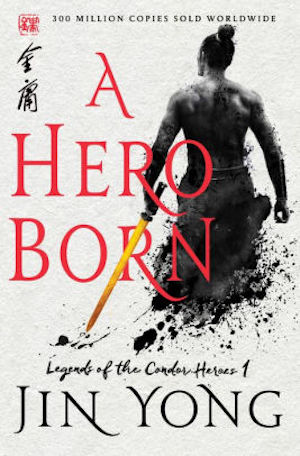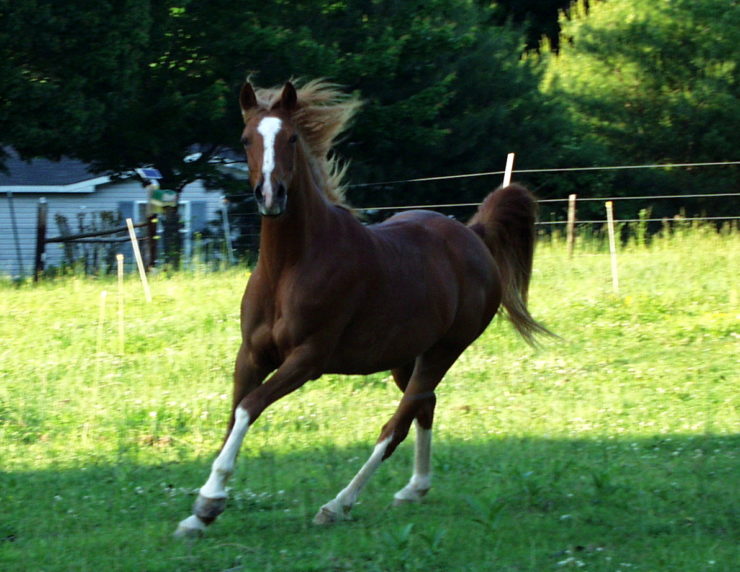Every horse breed has its myths and legends. There’s something special about each one, and story accretes to that specialness. Some of it’s true, some of it’s wishful thinking, but it’s all born out of love for one particular type and lineage of horse.
Of all the breeds we know in the West, especially the English-speaking West, the one that claims to be the oldest is the Arabian. Before Ladyhawke and the domination of the “Romantic” breeds in genre film and costume drama, the Arabian was the go-to fantasy horse. Walter Farley’s The Black Stallion and its sequels depict a boy’s (and girl’s) dream horse, the beautiful black stallion from the mysterious desert. Another and somewhat more realistic vision is that of Marguerite Henry in King of the Wind, the story of a real horse, the Godolphin Arabian.
The legend of the breed owes a great deal to Victorian Orientalism, and that in turn grew out of the Napoleonic Wars. Napoleon’s famous warhorse, Marengo, was an Arabian. Even before that, as Henry’s book tells, Arabians and Barbs (the Berber horses of North Africa) had been finding their way into Northern Europe and contributing significantly to the foundation of the Thoroughbred horse. Besides the Godolphin Arabian, the Byerley Turk and the Darley Arabian founded famous lines of racehorses when crossed on English and Continental mares.
By the mid to late nineteenth century, the passion for all things “oriental,” or in this case Middle Eastern and Arabian, inspired a number of well-to-do and intrepid British citizens to mount expeditions to North Africa and the Arabian Peninsula in search of the original and perfect Arabian horse. Wilfrid Blunt and Lady Anne Blunt established the Crabbet Arabian Stud with a herd of imported horses, and their daughter Lady Wentworth continued the tradition into the twentieth century. Meanwhile breeders in Eastern Europe were importing their own breeding stock, as were breeders in Russia; by World War II there were significant numbers of Arabians in Poland and then Czechoslovakia, which were caught up in General Patton’s “Operation Cowboy” along with the Lipizzaners of the Spanish Riding School of Vienna.
What all of these breeders and enthusiasts were seeking and cultivating was the horse of the Arabian desert. It evolved there, and was domesticated by the ancestors of the Bedouin. How long ago that happened, or exactly how it happened, is better known to myth and legend than to history.
There are stories. How the breed is the oldest and purest of all, bred in the desert for the desert and prized above any other animal—living in the tents of the tribe, cherished like children. How the Prophet Muhammad selected five foundation mares through tests of intelligence and stamina, and those five were the ancestors of each of the five supposed types or lineages of Arabian. How the Bedouin preferred mares to stallions, because mares are quieter on raids, and stallions will scream to proclaim their presence and their availability to the local ladies and their antagonism to the local stallions.
Buy the Book


A Hero Born
Mares are certainly prized and their bloodlines are cherished. The West has a thing about stallions, which has tended to cast their mothers and sisters in the shade, but historical accounts talk about the lines of the great mares, and breeders acknowledge that a good stallion can stamp his quality on his get, but it’s the mare who gives the foal its strength and courage and its wisdom.
Behind all this history and lore and sometimes fantasy is a distinctive physical type. The Arabian is a smallish horse by modern standards, lightly built but deep in the chest and barrel. While individuals do vary, the classic Arabian has a unique head, with a concave profile and proportionally large nostrils and eyes. Its neck is set on upright and its tail is set high, with a dramatic arch—an Arabian’s tailset, like its profile, is a mark of the breed. It’s easy to spot an Arabian in a herd of horses, and horses with Arabian ancestors often inherit both the dished face and the high tail.
All of these physical traits are adaptations to the desert. Those slender-seeming bones are remarkably dense and strong, and the dramatically flared nostrils and the inflated frontal sinuses are designed to maximize the intake of oxygen—these horses are literally drinkers of the wind. Their body structure is designed to disperse heat while the animal runs, their muscles are designed for stamina, and they are fast. Not as fast as their descendants, the sprinter called the Quarter Horse or the miler called the Thoroughbred, but they are unmatched over distance for either speed or endurance. The mount for races up to 100 miles and more is the Arabian.
Arabian temperament has had a bad rap over the past few decades thanks to the tendency of show breeders to emphasize looks—and specifically head shape—over intelligence, but the original animal is famously smart and highly trainable. They are spirited and sensitive, and can be fiery, but a well-bred Arabian is tremendously sweet and kind. Arabian stallions are as kid-safe as stallions get; in the Arab world where geldings are not nearly as common as they are in the West, the concept of the sex-crazed hormonal maniac is met with a long, slow stare.
As beautiful and striking as the Arabian is in itself, it has even more value as an outcross. Horseman’s wisdom has it that any breed can be improved by the addition of Arabian blood. That again has lost ground in the past fifty years or so, but from the eighteenth through the late twentieth centuries, it was known that if you wanted to improve your herd’s beauty, stamina, and intelligence, you looked to the Arabian. A large number of breeds from the Thoroughbred to the Morgan to the Andalusian (shhhh, don’t tell, they’re supposed to be a “pure” breed these days) all the way to the Percheron have Arabian ancestry.
I think it’s fair to say the Arabian is one of the core breeds, at least in the West. Regardless of whether it’s actually the oldest, it is one of the oldest, and its lines have been kept pure, confined to specific bloodlines from specific regions, for centuries if not millennia. It’s genetically consistent, in short, and those genetics have contributed to a significant proportion of extant horse breeds.
It’s indeed a fantasy horse—the progenitor of many a fantasy unicorn and equinoid companion—but it’s also a real, functional, useful animal. That’s the best of both worlds.
Top image by Patrick Edwin Moran, licensed under the Creative Commons Attribution 2.0 Generic license, via WikiMedia Commons.
Judith Tarr is a lifelong horse person. She supports her habit by writing works of fantasy and science fiction as well as historical novels, many of which have been published as ebooks by Book View Cafe. She’s even written a primer for writers who want to write about horses: Writing Horses: The Fine Art of Getting It Right. Her most recent novel, Dragons in the Earth, features a herd of magical horses, and her space opera, Forgotten Suns, features both terrestrial horses and an alien horselike species (and space whales!). She lives near Tucson, Arizona with a herd of Lipizzans, a clowder of cats, and a blue-eyed dog.










